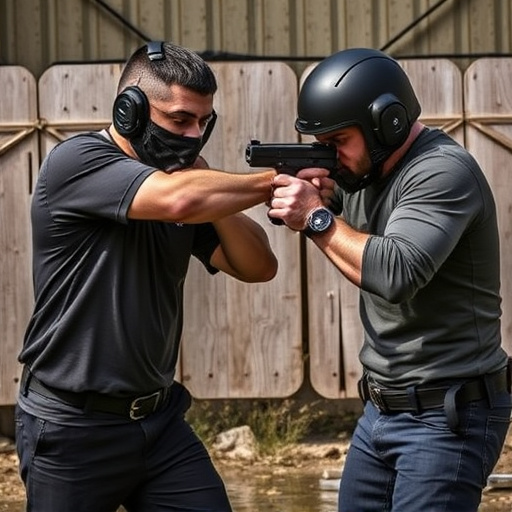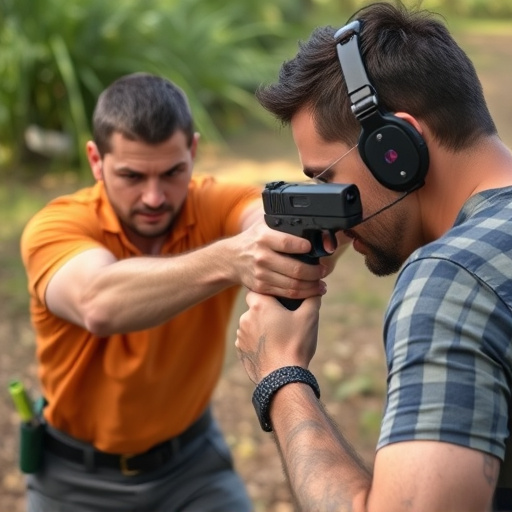Stun guns, though effective for personal defense, pose a significant risk of interference with pacemakers due to their high-voltage electrical pulses (EMPs). The electric current can disrupt the cardiac rhythm regulated by pacemakers, leading to life-threatening complications. Individuals with pacemakers are advised to consult healthcare providers before using stun guns and consider safer alternatives like pepper spray or personal alarms to avoid potential harm.
Personal defense weapons, particularly stun guns, have gained popularity as non-lethal options. However, their electrical discharge mechanisms raise concerns for individuals with pacemakers, given the potential for interference. This article delves into the science behind electrical discharge weapons and examines their impact on pacemaker functionality. We explore safety precautions, discuss risks, and present alternative personal defense choices for those with pacemakers, offering valuable insights in light of these considerations regarding stun guns and pacemaker interference.
- Understanding Electrical Discharge Weapons: A Brief Overview
- The Impact of Stun Guns on Pacemakers: Risks and Considerations
- How Stun Guns Interfere with Pacemaker Functionality
- Precautions and Safety Measures for Users with Pacemakers
- Exploring Alternative Personal Defense Options for Pacemaker Wearers
Understanding Electrical Discharge Weapons: A Brief Overview

Electrical discharge weapons, commonly known as stun guns or tasers, have gained popularity for personal defense purposes. These devices work by delivering a powerful electric current to temporarily disable an attacker, providing users with time to escape or seek help. The technology behind them is based on generating a high-voltage, low-current electrical pulse that interrupts the body’s natural electrical signals, specifically targeting the nervous system. This disruption causes muscle spasms and temporary paralysis, rendering the target immobilized for several minutes.
One critical consideration with stun guns is their potential interference with medical devices like pacemakers. Due to their electrical nature, stun guns can emit electromagnetic pulses (EMPs) that may impact nearby electronic devices. In the case of individuals with pacemakers, this could lead to adverse effects or even malfunctions in the device’s programming. Thus, users should be cautious and informed about potential risks, especially when operating these weapons near sensitive medical equipment, like pacemakers.
The Impact of Stun Guns on Pacemakers: Risks and Considerations

Stun guns, while designed to incapacitate an assailant with a powerful electrical shock, have specific risks associated with individuals who rely on pacemakers. These devices work by delivering a high-voltage electric current, which can disrupt normal cardiac rhythm and cause muscle contractions. However, for pacemaker users, this discharge can pose significant challenges. The electrical impulses from stun guns may interfere with the proper functioning of pacemakers, potentially causing them to malfunction or deliver inappropriate shocks.
This interference is a critical consideration as it could lead to dangerous consequences for individuals with heart conditions. Even temporary disruption of a pacemaker’s rhythm can be life-threatening. Therefore, those who carry stun guns for personal defense should be aware of the potential risks and take precautions when using such devices in close proximity to pacemakers. Medical professionals often advise against the use of stun guns for people with cardiac implants, emphasizing the need for alternative self-defense strategies for this vulnerable population.
How Stun Guns Interfere with Pacemaker Functionality

Stun guns, while designed to incapacitate an assailant with a powerful electric shock, can have severe consequences for individuals with pacemakers. These devices function by delivering a high-voltage electric current through the body, disrupting muscle control and causing temporary paralysis. However, this electrical discharge can interfere with the proper functioning of artificial pacemakers, which rely on precise electrical signals to regulate heartbeats.
The impact of stun guns on pacemaker functionality is significant due to the close proximity of the device’s electrodes to the heart. The electric current generated by a stun gun can potentially alter or block the pacemaker’s signals, leading to irregular heartbeat rhythms, including bradycardia (slow heart rate) or even stopping the heart momentarily. This complication is particularly concerning for individuals who depend on pacemakers for their survival, emphasizing the need for caution when considering personal defense options in such cases.
Precautions and Safety Measures for Users with Pacemakers

Using a stun gun as a personal defense weapon can be life-saving, but it’s crucial to understand potential risks for users with pacemakers. Stun guns emit an electrical discharge that can interfere with electronic devices, including pacemakers, potentially causing them to malfunction or even stop. This risk of pacemaker interference is a significant concern for individuals relying on these devices for medical reasons.
To ensure safety, users with pacemakers should take precautions when considering stun gun use. Consulting with a healthcare provider is essential to assess individual risks and make an informed decision. Additionally, choosing stun guns designed with reduced electromagnetic interference (EMI) can help mitigate the risk of pacemaker disruption. Always follow manufacturer instructions and store stun guns away from pacemakers and other electronic devices to minimize potential harm.
Exploring Alternative Personal Defense Options for Pacemaker Wearers

For individuals with pacemakers, the choice of personal defense weapons can be a complex consideration due to potential interference concerns. Stun guns, for instance, operate by delivering an electric shock to incapacitate an attacker, but they may cause unpredictable effects on a pacemaker’s functionality. This is because stun devices generate high voltage electrical discharges, which could interfere with the precise timing and regulation of a pacemaker’s rhythm. As such, those with these heart devices are often advised to avoid or be cautious when using stun guns for self-defense.
Exploring alternative options becomes essential in this scenario. Non-lethal weapons like pepper spray or personal alarm devices can offer effective protection without the risk of electrical interference. These alternatives provide a safe and legal method of self-defense, especially considering the unique health considerations for pacemaker wearers.
While stun guns offer a perceived sense of personal security, their electrical discharge can pose significant risks to individuals with pacemakers. The potential for pacemaker interference during use necessitates a balanced approach to self-defense. By understanding the dangers and exploring alternative options, individuals with pacemakers can protect themselves effectively while mitigating the risk of adverse interactions with stun guns. This knowledge empowers users to make informed decisions regarding their personal safety in various situations.
